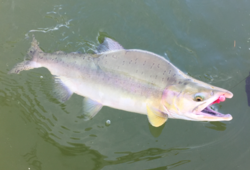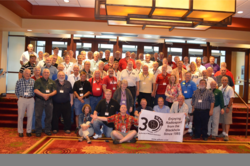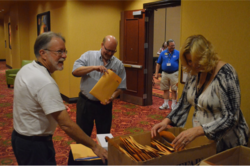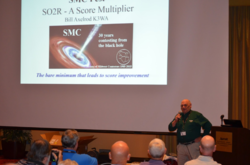 September 9, 2015 Editor: Paul Bourque, N1SFE | ||||||
IN THIS ISSUE · Lockdown for commodity WiFi gear? · SMC fest NEW HF OPERATORS - THINGS TO DO
It's going to be getting very, very busy, very soon. October's calendar is chock full of events. You'd better be finishing up your outside antenna work. If you're up for a fun challenge this week, try the Worked All Europe DX Contest. US stations can only work Europe, and the contest has a special feature of QTCs (telegrams) - which count like additional contacts. The QTCs you send contain the QSO information from previous contacts. It sounds complicated, and it can be, but that's one of the reasons why it's fun to master. Your logging program (e.g. N1MM Logger+) can assist with the QTC mechanical aspects. If the bands aren't open to Europe... you might try (or at least listen to) the NA CW Sprint on 0000-0400z September 13 (Saturday evening in the US). Only four hours long, it can be daunting, frustrating, difficult, exhilarating, enjoyable, and fun as you get the hang of it.
The weekend of the 19th, dependable choices propagation-wise are QSO Parties for South Carolina, New Jersey, and Washington. If you liked the CW Sprint, try the RTTY Sprint. BULLETINS At the time of this writing, the FCC's Universal Licensing System is currently unavailable, due to system upgrades. It is expected to be on line again after September 10, 2015. The Pacific Northwest VHF Society's 21st Annual VHF-UHF-Microwave Conference will be held in Issaquah, Washington, October 10-11, 2015. BUSTED QSOS Apparently the last issue was "Golden enough." CONTEST SUMMARY Complete information for all contests follows the Conversation section September 10 September 11 September 12
September 13 September 16 September 17 September 18 September 19
September 20
September 21 September 22 September 23 The FCC has published an NPRM affecting manufacturers of Wi-Fi equipment to restrict the ability of after-sale changes (via software changes or updates) by third parties to enable the devices (through software-settable RF parameters) to operate outside of their certification parameters. Such restrictions could make it more difficult (if not impossible) for alternate router firmware (e.g. OpenWRT, DD-WRT, Tomato, broadband-hamnet) to operate on these devices. Commodity consumer Wi-Fi hardware is currently being repurposed to support a wide range of amateur activities at 900 MHz and above (e.g. broadband-hamnet). It's mesmerizing to watch during the summer months in North America - Live lightning strike maps, and this one too! Though they've been reported since the beginning of high-altitude flying, red sprites emanating from the TOPS of thunderstorms aren't completely understood. The best views can be from space. Researchers recently had a good oops, and accidently quadrupled a lithium ion battery's lifespan. The accident was leaving electrode materials in an acid bath too long; this put a titanium hydroxide coating on a core of aluminum... ("You've got your titanium hydroxide on my aluminum! You've got your aluminum in my titanium hydroxide!") A recap of the historic solar storm of 1859 was recently featured on spaceweather.com. The consequences of such an event in today's world would be severe. Morse Code and a camera were allegedly being used to cheat in a chess tournament, according to the BBC. The player was allegedly blinking out communications to a conspirator that was feeding moves into a computer, and responding with moves. It's not good to get sore from sitting around, contesting. The Cleveland Clinic has some suggestions on how to treat your body better, through better posture. A better contest score depends on your 'butt in seat' time. Today, with all of the information available to us during a contest, controlling everything can be daunting at times. If one were to combine the use of the butt in seat with a special seat to control things... we'd need a combination of technologies to get the job done. TI may be in the right place at the right time. They have an example design http://www.ti.com/tool/tida-00314 which combines a multi-axis inductance-to-digital converter, along with a haptic-feedback IC , to enable a sealed ("environmentally resistant!") design which can not only take input, but provide feedback. If you're familiar with newer Apple laptop hardware with Force Touch trackpads, you may be familiar with the use of haptic feedback to trick our brains into thinking pressing on a fixed, sealed metal plate actually causes movement. Imagine if at the next 'send cw with your glutes' contest, you're faced with a butt-sized paddle? Feedback would definitely be helpful, and perhaps even inspirational. One could imagine the further refinement of haptic technology to suit our contesting needs: a peripheral used during the contest to enable additional logging functions. Imagine adding another special-function Shift key? Buttswitch inputs, both left and right. Special feedback to announce the spot of a needed mult. Behinders, er, reminders to switch bands as the rate drops. Such a peripheral could be just the kick in the pants needed to make it through the slow times. Two researchers from the Naval Research Laboratory are predicting that Solar Cycle 25 will be similar in amplitude to Cycle 24. (Thanks W3LPL via Topband reflector). Web Site of the Week - NCDXF Beacons The Northern California DX Foundation sponsors a network of worldwide beacons on 20 through 10 meters. These can provide an important tool for which bands are open at particular times. In the days preceding a contest, it can be useful to monitor these beacons to understand what you can hear from your station at various points during the day. On a particular schedule, stations in various parts of the world transmit a readily identifiable CW signal at varying power levels. There are beacon id programs for your desktop computer and smartphone to help determine which beacon your hear, or should be hearing. The beacons are reduced in utility during contest weekends as operators forget about them and use the beacon frequencies. WORD TO THE WISE - FSQ FSQ stands for Fast Simple QSO. Developed by ZL2AFP and ZL1BPU, it's a channelized communications mode designed for HF, which evolved from WSQ2. It features quick link turnaround time, and suitability for propagation conditions found on HF. It is finding application in being used for 'chat' type communications. As it is channelized, it's not particularly suited for situations where the communications frequencies are not established beforehand. K9CT sends information on the recent SMC Fest, which was held August 22nd:
"2015 SMC Fest is now history. Over 70 of our members met at the Marriott in Normal, IL and shared their contesting stories. We celebrated 30 Years as a contest club and Dave Patton, NN1N recounted the early days of the SMC. Several presentations were made by K9WX, N0AX, K2DRH, W9RE, K9ZO, K3WA, and K9CT on subjects ranging from VHF contesting, WRTC to SO2R. It seemed like we had something for everyone including a special 30th anniversary cake designed by Ralph, K9ZO.
The first few years of the club had about 80 paid members. We reset our membership a few years ago and now have about 280 paid members that are active. Recent interests have been the NAQP competition with NCCC and PVRC, Sweepstakes and the big DX contests by CQ and ARRL. We have supported WRTC, contest plaques and awards for our membership.
SMC will be supporting the W9DXCC with the addition of Contest University for the new contester." (Text courtesy of K9CT, pictures by K9QQ) Sending out paper certificates to contest participants can be expensive. Considering the cost of reasonably nice paper, an envelope, printing, and postage, it could be several dollars per certificate. To reduce costs, some contests have changed to provide a self-print option for certificate winners. The CQWW Contest committee is soliciting opinions on "the future of paper certificates" via their blog. OPERATING TIP The band is open to Elbonia... I think. One way to tell is to use the reverse beacon network, and choose a receiving site that is near you. Hopefully, an Elbonian station is calling CQ, so that there's a chance that it can be picked up by the RBN. You can also CQ (using CW), and see if the Elbonian RBN receiver can hear you. Another way is to listen for fixed stations at known locations on particular frequencies in or near the amateur bands. OK1RP has put together an updated list of Topband-related beacons, which can sometimes be heard on or near 160 meters. Though it's nice to know where a beacon originates, sometimes it's enough just to know 160 meters is open. Another technique for 160 meters is to monitor the top end of the AM Broadcast band. For 20-10 meters, don't forget the NCDXF beacons, mentioned earlier. There was a stir in the media recently about using magnetic fields to communicate between on-person sensors and smart devices. Potential benefits for personal devices were seen in lower power consumption, and shorter range. More fusion reactor news: A private company is announcing some breakthroughs, primarily in reactor design. If you're experiencing eye strain or just want a change of scenery during heavy logging program use, try a different font for better readability. A typeface is available which is optimized for 8-12 pixel fonts on modern display equipment. Using the typeface Hack, lowercase "L" and the number "one" are easily distinguishable, and zero stands apart from the letter "O" (Thanks NN4X via cq-contest). Here are some useful tips on using an oscilloscope to track down sources of EMI in electronic designs. When researching how to fix an ailing transceiver, which has an extensive amount of SMD devices, I came across some videos from IFixit on how to do microsoldering - soldering really small things. The level of integration on the (>12 year old) rig isn't the same as say, my iPhone, but some of the equipment and techniques are applicable. W9IB and K2TXB have released an update to their WinBD program. This Windows application calculates bearing and distance to a four or six character grid location, and would be useful if you were VHF/UHF Roving. NIST is forming an alliance with industry to develop propagation models for millimeter wave bands which are anticipated to be used with 5G communications. Coilcraft has published a paper on how to select appropriate components for use in Bias-T applications (you may need to trade your email address for access). A Bias-T allows power and RF to be sent via one cable - sometimes it's called a power injector. It's Wi-Fi all the way down... below 1 GHz. 802.11ah is a standard for communication on frequencies below 1GHz. It's targeted more towards devices communicating vs. web browsing. You'll likely be hearing more about this category standard as part of MtM (or M2M) (Machine to Machine) communications for the IoT (Internet of Things). There's a bit of a backlash occurring when everything is sprinkled with Internet-enabling dust: The Internet Of Way Too Many Things. Technical Web Site of the Week - The Cabrillo specification was created by Trey Garlough, N5KO, to provide a log file format that computer logging programs could generate, computerized scoring programs could digest, yet remained editable with a text editor. Now in it's third version, the Cabrillo Standard has a home on the web site of the WWROF. You may need to consult the standard if you're a contest sponsor, and have special entry categories that log scoring has to handle, or if you're running a contest-within-a-contest and require some special fields, or if you're wondering why the contest robot is rejecting your log. There are all manner of tools to convert to/from Cabrillo available at your beck and search engine query. The ARRL offers a tutorial on the format, including a template for the ARRL Sweepstakes. Post Recruitment Let's say you've been successful in getting someone who isn't a "big contester", or even a little contester, yet, to show up to field day. He/she had a positive experience, because you've followed up with him/her, or were there to (Elmer) mentor him/her. Now is the time to find out what it was about the contesting experience that he/she enjoyed, so that you (and he/she) can build on their past positive experience with new ones. Some people will be self-starters, he/she knows what he's/she's interested in, and he/she went home after field day and got into a contest or two on his/her own. You might merely have to discuss some of the aspects of the various upcoming contests, and he/she will be filling her own weekend calendars well into spring. Your role here is a support resource, and to channel his/her energy into a range of activities, so he/she will better understand what he/she likes and doesn't like. Maybe he/she will be inviting others over to his/her QTH for a multi-op soon. You should cross your fingers that he/she gives his/her club contest points to your club. Others will have enjoyed the experience, but be stymied in his/her contesting next steps for lack of location, equipment, antennas, etc. You'll need to continue to offer (ask, don't tell) opportunities for him/her to participate. That participation may be in many forms - perhaps he/she liked station setup and construction, but was a little shy around the field day microphone. How about a RTTY contest? Is rate his/her thing? Ask him/her what he/she needs to be on the air in a contest. Note - what about some regular club members that you've not heard on the air lately? Ask him/her what he/she needs to be on the air in a contest. There are so many variables that can affect any particular contest experience - contest time, mode, frequency, exchange, propagation, equipment, antennas, team dynamics, etc. If you're doing a multi-op, don't forget the continued care and feeding of your new recruit. Involve him/her in all aspects of the contest operation and make sure his/her participation matters. While he/she might say "yes" to doing anything that's asked, it's up to you to figure out if you can put him/her on the 10 meter station for four hours CQing into a closed band. What motivates a person is feeling a sense of purpose and making constant progress. You, the Elmer, are helping to develop the talent of your recruit, not unlike what sports teams, corporations, non-profits, social organizations and the like must do to be successful. Remember to balance the needs of the organization (the contest effort) with the needs of the operators - and have fun! 73, Brian N9ADG 10 Sep - 23 Sep 2015 An expanded, downloadable version of QST's Contest Corral in PDF format is available. Check the sponsor's Web site for information on operating time restrictions and other instructions. HF CONTESTS CWops Mini-CWT Test, Sep 9, 1300z to Sep 9, 1400z, Sep 9, 1900z to Sep 9, 2000z, Sep 10, 0300z to Sep 10, 0400z; CW; Bands: 160, 80, 40, 20, 15, 10m; Member: Name + Member No., non-Member: Name + (state/province/country); Logs due: September 12. NCCC RTTY Sprint Ladder, Sep 11, 0145z to Sep 11, 0215z; RTTY; Bands: 160, 80, 40, 20, 15m; Serial No. + Name + QTH; Logs due: September 13. NCCC Sprint, Sep 11, 0230z to Sep 11, 0300z; (see rules); Bands: (see rules); Serial No. + Name + QTH; Logs due: September 13. Kulikovo Polye Contest, Sep 12, 0000z to Sep 12, 2359z; CW; Bands: 20m Only; KP: RST + "KP", non-KP: RST + Serial No.; Logs due: September 27. FOC QSO Party, Sep 12, 0000z to Sep 12, 2359z; CW; Bands: 160, 80, 40, 20, 15, 10, VHF; FOC-Member: RST + Name + Member No., non-Members: RST + Name; Logs due: September 26. WAE DX Contest, SSB, Sep 12, 0000z to Sep 13, 2359z; SSB; Bands: 80, 40, 20, 15, 10m; RS + Serial No.; Logs due: September 28. SARL Field Day Contest, Sep 12, 1000z to Sep 13, 1000z; CW, SSB, Digital; Bands: 160, 80, 40, 20, 15, 10m; RS(T) + Number of transmitters + Category (see rules) + Province (or "DX"); Logs due: September 27. SKCC Weekend Sprintathon, Sep 12, 1200z to Sep 14, 0000z; CW; Bands: 160, 80, 40, 20, 15, 10, 6m; RST + (state/province/country) + Name + (SKCC No./"NONE"); Logs due: September 19. Arkansas QSO Party, Sep 12, 1400z to Sep 13, 0200z; CW, Phone, Digital; Bands: 80, 40, 20, 15, 10, 2m; AR: RS(T) + County, non-AR: RS(T) + (state/province/"DX"); Logs due: September 26. Ohio State Parks on the Air, Sep 12, 1600z to Sep 13, 0000z; SSB; Bands: 80, 40, 20, 15, 10m; OH Park: park abbreviation, OH: "Ohio", W/VE: (state/province), DX: "DX"; Logs due: September 26. North American Sprint, CW, Sep 13, 0000z to Sep 13, 0400z; CW; Bands: 80, 40, 20m; [other station's call] + [your call] + [serial no.] + [your name] + [your state/province/country]; Logs due: September 20. Swiss HTC QRP Sprint, Sep 13, 1300z to Sep 13, 1900z; CW; Bands: 80, 40, 20m; RST + "/" + Class + "/" + (kanton, province, etc.) + "/" + first name; Logs due: see rules. Phone Fray, Sep 16, 0230z to Sep 16, 0300z; SSB; Bands: 160, 80, 40, 20, 15m; NA: Name + (state/province/country), non-NA: Name; Logs due: September 11. CWops Mini-CWT Test, Sep 16, 1300z to Sep 16, 1400z, Sep 16, 1900z to Sep 16, 2000z, Sep 17, 0300z to Sep 17, 0400z; CW; Bands: 160, 80, 40, 20, 15, 10m; Member: Name + Member No., non-Member: Name + (state/province/country); Logs due: September 12. NAQCC CW Sprint, Sep 17, 0030z to Sep 17, 0230z; CW; Bands: 80, 40, 20m; RST + (state/province/country) + (NAQCC No./power); Logs due: September 20. NCCC RTTY Sprint Ladder, Sep 18, 0145z to Sep 18, 0215z; RTTY; Bands: 160, 80, 40, 20, 15m; Serial No. + Name + QTH; Logs due: September 13. NCCC Sprint, Sep 18, 0230z to Sep 18, 0300z; (see rules); Bands: (see rules); Serial No. + Name + QTH; Logs due: September 13. AGB NEMIGA Contest, Sep 18, 2100z to Sep 19, 0000z; CW, SSB, Digital; Bands: 80m Only; AGB Member: RST + QSO No. + Member No., non-Member: RST + QSO No.; Logs due: October 18. Scandinavian Activity Contest, CW, Sep 19, 1200z to Sep 20, 1200z; CW; Bands: 80, 40, 20, 15, 10m; RST + Serial No.; Logs due: September 27. SRT HF Contest SSB, Sep 19, 1300z to Sep 20, 1300z; SSB; Bands: 160, 80, 40, 20, 15, 10m; RS + CQ Zone; Logs due: see rules. South Carolina QSO Party, Sep 19, 1400z to Sep 20, 0300z; CW, Digital, Phone; Bands: 160, 80, 40, 20, 15, 10, 6m; SC: RS(T) + County, non-SC: RS(T) + (state/province/"DX"); Logs due: October 19. Washington State Salmon Run, Sep 19, 1600z to Sep 20, 0700z, Sep 20, 1600z to Sep 21, 0000z; CW, SSB, Digital; Bands: 160, 80, 40, 20, 15, 10, 6, 2m; WA: RS(T) + County, non-WA: RS(T) + (state/province/country); Logs due: October 4. New Jersey QSO Party, Sep 19, 1600z to Sep 20, 0359z, Sep 20, 1400z to Sep 20, 2000z; CW, Phone; Bands: 80, 40, 20, 15, 10m; NJ: RS(T) + county, non-NJ: RS(T) + (state/province/"DX"); Logs due: October 1. QRP Afield, Sep 19, 1600z to Sep 19, 2200z; All; Bands: 160, 80, 40, 20, 15, 10m; RS(T) + (state/province/country/IOTA/USi) + (power or NE QRP No.); Logs due: October 19. Feld Hell Sprint, Sep 19, 1800z to Sep 19, 1959z; Feld Hell; Bands: 160, 80, 40, 15, 10, 6m; (see rules); Logs due: September 26. North American Sprint, RTTY, Sep 20, 0000z to Sep 20, 0400z; RTTY; Bands: 80, 40, 20m; [other station's call] + [your call] + [serial no.] + [your name] + [your state/province/country]; Logs due: September 27. Classic Exchange, CW, Sep 20, 1300z to Sep 21, 0800z, Sep 22, 1300z to Sep 23, 0800z; CW; Bands: 160, 80, 40, 20, 15, 10, 6, 2m; Name + RST + (state/province/country) + rcvr/xmtr manuf/model; Logs due: November 30. BARTG Sprint 75, Sep 20, 1700z to Sep 20, 2100z; 75 Baud RTTY; Bands: 80, 40, 20, 15, 10m; Serial No.; Logs due: September 27. Run for the Bacon QRP Contest, Sep 21, 0100z to Sep 21, 0300z; CW; Bands: 160, 80, 40, 20, 15, 10m; RST + (state/province/country) + (Member No./power); Logs due: September 27. SKCC Sprint, Sep 23, 0000z to Sep 23, 0200z; CW; Bands: 160, 80, 40, 20, 15, 10m; RST + (state/province/country) + Name + (SKCC No./power); Logs due: September 25. Pirate QSO Party, Sep 23, 0030z to Sep 23, 0330z; SSB; Bands: 40, 20, 15m; (see rules); Logs due: September 30. Phone Fray, Sep 23, 0230z to Sep 23, 0300z; SSB; Bands: 160, 80, 40, 20, 15m; NA: Name + (state/province/country), non-NA: Name; Logs due: September 11. CWops Mini-CWT Test, Sep 23, 1300z to Sep 23, 1400z, Sep 23, 1900z to Sep 23, 2000z, Sep 24, 0300z to Sep 24, 0400z; CW; Bands: 160, 80, 40, 20, 15, 10m; Member: Name + Member No., non-Member: Name + (state/province/country); Logs due: September 12. VHF+ CONTESTS
ARRL 10 GHz and Up Contest, Sep 19, 0600 (local) to Sep 21, 0000 (local); Any; Bands: 10 GHz to light; 6-Character Maidenhead Locator; Logs due: October 20.
144 MHz Fall Sprint, Sep 21, 1900z to Sep 21, 2300z; not specified; Bands: 2m Only; 4-character grid square; Logs due: October 5. LOG DUE DATES 10 Sep - 23 Sep 2015 September 10, 2015 September 11, 2015 September 12, 2015 September 13, 2015 September 15, 2015 September 16, 2015 September 17, 2015 September 19, 2015 September 20, 2015 September 21, 2015 September 22, 2015 ARRL Information Click here to advertise in this newsletter, space subject to availability. Your One-Stop Resource for Amateur Radio News and Information ARRL membership includes QST, Amateur Radio's most popular and informative journal, delivered to your mailbox each month. Subscribe to NCJ - the National Contest Journal. Published bimonthly, features articles by top contesters, letters, hints, statistics, scores, NA Sprint and QSO Parties. Subscribe to QEX - A Forum for Communications Experimenters. Published bimonthly, features technical articles, construction projects, columns and other items of interest to radio amateurs and communications professionals. Free of charge to ARRL members: Subscribe to The ARRL Letter (weekly digest of news and information), the ARES E-Letter (monthly public service and emergency communications news), Division and Section news -- and much more! ARRL offers a wide array of products to enhance your enjoyment of Amateur Radio. Visit the site often for new publications, specials and sales. Donate to the fund of your choice -- support programs not funded by member dues! Reprint permission can be obtained by sending email to permission@arrl.org with a description of the material and the reprint publication. ACKNOWLEDGEMENTS ARRL Contest Update wishes to acknowledge information from WA7BNM's Contest Calendar and SM3CER's Contest Calendar. | ||||||
.jpg)










